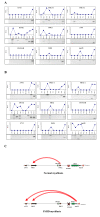A functional role for 4qA/B in the structural rearrangement of the 4q35 region and in the regulation of FRG1 and ANT1 in facioscapulohumeral dystrophy
- PMID: 18852887
- PMCID: PMC2561064
- DOI: 10.1371/journal.pone.0003389
A functional role for 4qA/B in the structural rearrangement of the 4q35 region and in the regulation of FRG1 and ANT1 in facioscapulohumeral dystrophy
Abstract
The number of D4Z4 repeats in the subtelomeric region of chromosome 4q is strongly reduced in patients with Facio-Scapulo-Humeral Dystrophy (FSHD). We performed chromosome conformation capture (3C) analysis to document the interactions taking place among different 4q35 markers. We found that the reduced number of D4Z4 repeats in FSHD myoblasts was associated with a global alteration of the three-dimensional structure of the 4q35 region. Indeed, differently from normal myoblasts, the 4qA/B marker interacted directly with the promoters of the FRG1 and ANT1 genes in FSHD cells. Along with the presence of a newly identified transcriptional enhancer within the 4qA allele, our demonstration of an interaction occurring between chromosomal segments located megabases away on the same chromosome 4q allows to revisit the possible mechanisms leading to FSHD.
Conflict of interest statement
Figures




Similar articles
-
ZNF555 protein binds to transcriptional activator site of 4qA allele and ANT1: potential implication in Facioscapulohumeral dystrophy.Nucleic Acids Res. 2015 Sep 30;43(17):8227-42. doi: 10.1093/nar/gkv721. Epub 2015 Jul 15. Nucleic Acids Res. 2015. PMID: 26184877 Free PMC article.
-
Remodeling of the chromatin structure of the facioscapulohumeral muscular dystrophy (FSHD) locus and upregulation of FSHD-related gene 1 (FRG1) expression during human myogenic differentiation.BMC Biol. 2009 Jul 16;7:41. doi: 10.1186/1741-7007-7-41. BMC Biol. 2009. PMID: 19607661 Free PMC article.
-
Testing the position-effect variegation hypothesis for facioscapulohumeral muscular dystrophy by analysis of histone modification and gene expression in subtelomeric 4q.Hum Mol Genet. 2003 Nov 15;12(22):2909-21. doi: 10.1093/hmg/ddg323. Epub 2003 Sep 23. Hum Mol Genet. 2003. PMID: 14506132
-
Facioscapulohumeral Muscular Dystrophy.Compr Physiol. 2017 Sep 12;7(4):1229-1279. doi: 10.1002/cphy.c160039. Compr Physiol. 2017. PMID: 28915324 Review.
-
Molecular diagnosis of facioscapulohumeral muscular dystrophy.Expert Rev Mol Diagn. 2002 Mar;2(2):160-71. doi: 10.1586/14737159.2.2.160. Expert Rev Mol Diagn. 2002. PMID: 11962336 Review.
Cited by
-
Decreased proliferation kinetics of mouse myoblasts overexpressing FRG1.PLoS One. 2011;6(5):e19780. doi: 10.1371/journal.pone.0019780. Epub 2011 May 16. PLoS One. 2011. PMID: 21603621 Free PMC article.
-
Defective regulation of microRNA target genes in myoblasts from facioscapulohumeral dystrophy patients.J Biol Chem. 2013 Dec 6;288(49):34989-5002. doi: 10.1074/jbc.M113.504522. Epub 2013 Oct 20. J Biol Chem. 2013. PMID: 24145033 Free PMC article.
-
Facioscapulohumeral dystrophy: the path to consensus on pathophysiology.Skelet Muscle. 2014 Jun 10;4:12. doi: 10.1186/2044-5040-4-12. eCollection 2014. Skelet Muscle. 2014. PMID: 24940479 Free PMC article. Review.
-
Alternative splicing and muscular dystrophy.RNA Biol. 2010 Jul-Aug;7(4):441-52. doi: 10.4161/rna.7.4.12258. Epub 2010 Jul 1. RNA Biol. 2010. PMID: 20603608 Free PMC article. Review.
-
New multiplex PCR-based protocol allowing indirect diagnosis of FSHD on single cells: can PGD be offered despite high risk of recombination?Eur J Hum Genet. 2010 May;18(5):533-8. doi: 10.1038/ejhg.2009.207. Epub 2009 Nov 25. Eur J Hum Genet. 2010. PMID: 19935833 Free PMC article.
References
-
- van Deutekom JC, Wijmenga C, van Tienhoven EA, Gruter AM, Hewitt JE, et al. FSHD associated DNA rearrangements are due to deletions of integral copies of a 3.2 kb tandemly repeated unit. Hum Mol Genet. 1993;2:2037–2042. - PubMed
-
- van Geel M, Heather LJ, Lyle R, Hewitt JE, Frants RR, et al. The FSHD region on human chromosome 4q35 contains potential coding regions among pseudogenes and a high density of repeat elements. Genomics. 1999;61:55–65. - PubMed
-
- Dmitriev P, Lipinski M, Vassetzky YS. Pearls in junk: dissecting the molecular pathogenesis of facioscapulohumeral muscular dystrophy. 2008. Neuromuscular Disorders in press: DOI: 10.1016/j.nmd.2008.1009.1004. - PubMed
-
- Gabellini D, Green MR, Tupler R. Inappropriate gene activation in FSHD: a repressor complex binds a chromosomal repeat deleted in dystrophic muscle. Cell. 2002;110:339–348. - PubMed
Publication types
MeSH terms
Substances
LinkOut - more resources
Full Text Sources
Other Literature Sources

